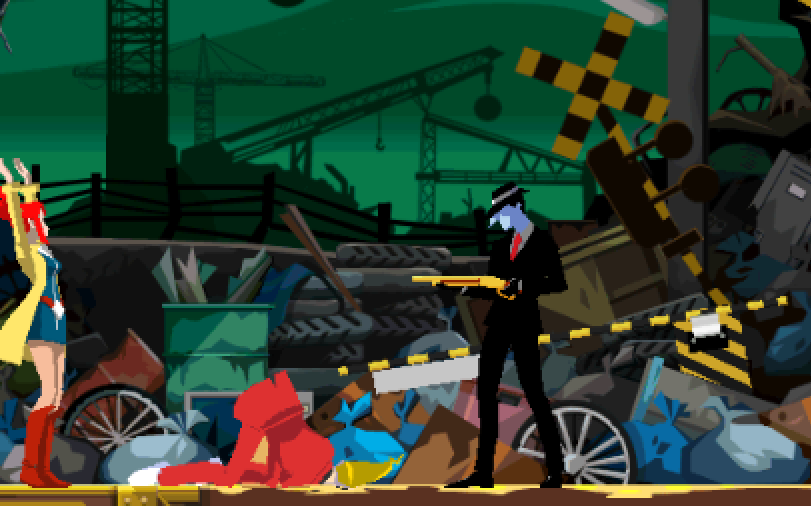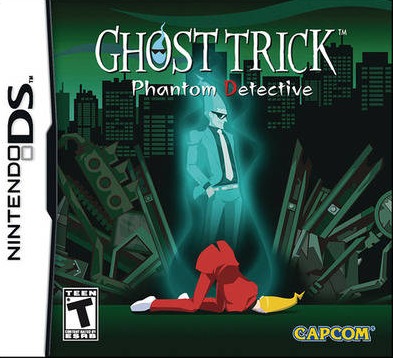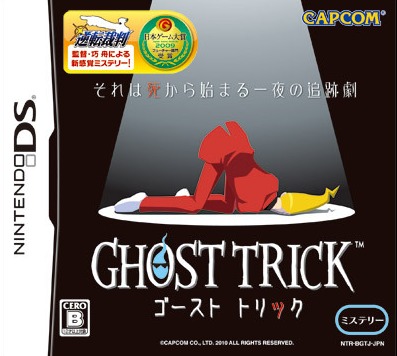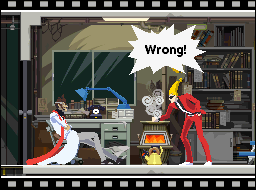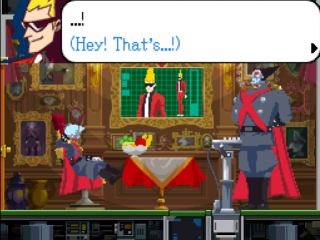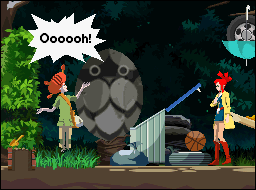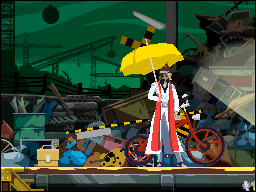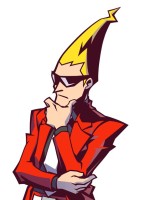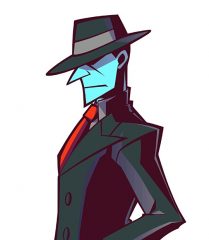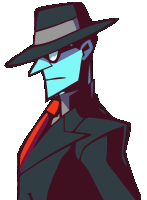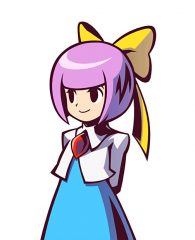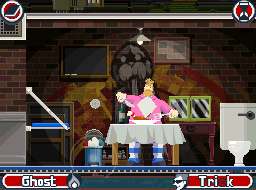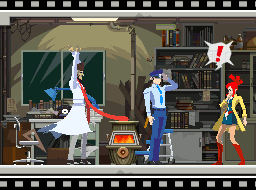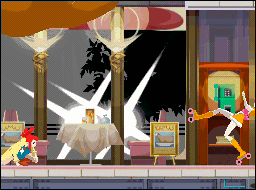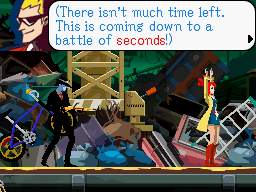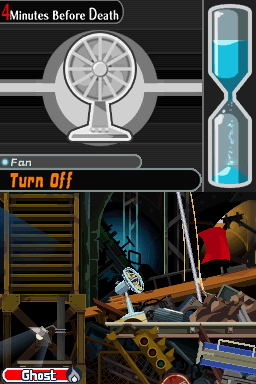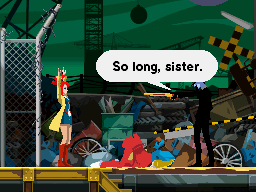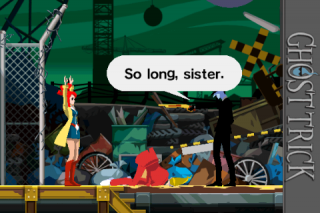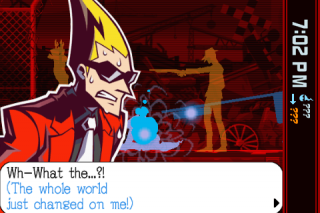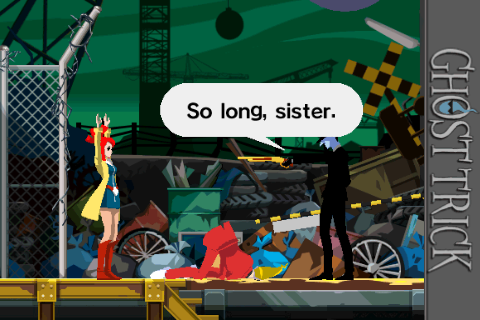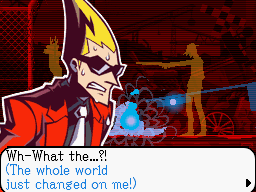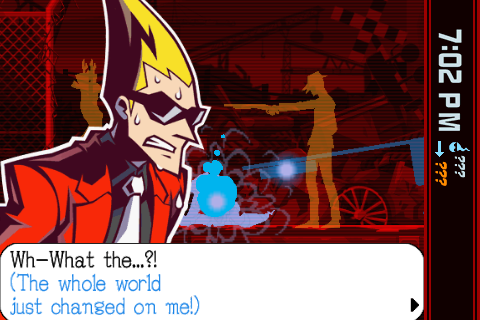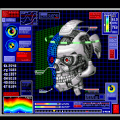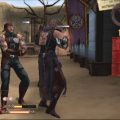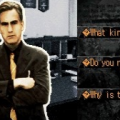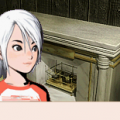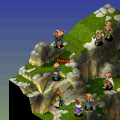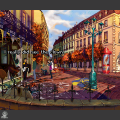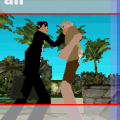Shortly after Apollo Justice: Ace Attorney was released in the United States, Ace Attorney series director Shu Takumi announced his retirement from the series. His next project, Ghost Trick, was to be something of a departure from the more visual novel oriented storytelling and courtroom drama, and focus more on slightly action-oriented puzzle solving at the hands of a protagonist who is dead before the game even starts. If it sounds crazy, it probably is. That’s Ghost Trick for you – a game that doesn’t tend to take itself too seriously, but is every bit as clever as the Ace Attorney games.
Ghost Trick casts you as a dead man. When the game begins, you find yourself slumped over on the ground at a junkyard. There is a woman in a trenchcoat, and a suit-clad hitman pointing a shotgun at her. But just when you think there’s nothing you can do to stop what’s inevitably going to happen, a voice tells you that there’s no point just sitting around being dead when you could save this woman from beyond the grave.
This initial scene serves as the game’s tutorial, teaching you about how to use your “tricks” to manipulate inanimate objects like crossing gates, guitars, and bicycles to startle the near-sighted hitman and save the girl. It’s a bit more complicated than just interacting with objects, though. In order to reach said objects, you need to jump between bits of scenery in the Ghost World. While you’re in the Ghost World, time stops, allowing you to jump around and inhabit the object that you wish to interact with. Exiting the Ghost World, however, starts things in motion again, and you’re on a tight 4-minute time limit in every chapter before the person you’re trying to save is killed in some manner. Timing is everything. Not to worry, though, if you happen to let your “target” die, you can rewind back to four minutes before their death and try again. The game is surprisingly forgiving in that respect.
Of course, the game isn’t all about just saving peoples’ lives. Since you’re dead, you have no memory of who killed you and why (and certain assumptions you might make from the introduction may or may not be true), so your ultimate goal through the game is to figure out who you are, and above all else, what you did prior to your death that resulted in these mysterious blue-skinned individuals putting a hit on you.
To get around the game world, you can jump between random objects in Ghost mode, but your range of motion is decidedly limited, so a lot of the puzzles involve somehow maneuvering objects into place via your Tricks so as to bridge the gap between distant objects. Timing is a major issue here, as you will occasionally need to jump between objects by using things that fall over or will otherwise only move once. In some situations, you will also need to be very careful not to let certain characters see you interacting with objects or else your cover is blown and you’ll have to restart the segment. These sections have a slight stealth element, but they’re generally nice enough to give you some warning so that you don’t have to restart the chapter too many times.
Obviously, your limited range of motion means you won’t be able to travel large distances, but you learn early on that ghosts are able to travel through the phone lines, so whenever a call is placed that you are able to eavesdrop on, you will learn the phone number on the opposite end, allowing you to quickly travel from one place to another through almost any telephone (unless it’s only an inside line – Ghost Trick‘s supernatural mechanics actually have some strict rules to them, which surprisingly make perfect sense in the context of the game world). Eventually, your range of motion becomes somewhat less of a problem, especially once you gain control of a second character who is able to jump a greater distance between objects, but can’t directly interact with objects, only swap similarly-shaped ones back and forth.
Characters
Sissel
This must be you. After all, there’s no other dead people in view at the start of the game, is there? Since you’re dead, you are only allowed limited interaction with the world, and you primarily learn new information regarding your strange death by eavesdropping on telephone conversations and speaking with those people that you’ve rescued, since apparently having been dead under certain circumstances grants a sort of localized “telepathy” effect with the person in question.
Nearsighted Jeego
The shotgun-wielding hitman who tries to kill Lynne in the game’s introduction. His motto is, “Nearsighted Jeego never misses a shot, as long as it’s within point blank range!” True to his name, he cannot see anything that’s any further than a few inches from his face; though his aim is uncanny, he is easily startled by sudden noises.
The Blue People
These strangely-colored individuals hail from an unnamed foreign country and will stop at nothing to kill Lynne, for reasons that don’t become at all clear until near the very end of the game. They are the ones that ordered the deaths of you and Lynne, but beyond that, it’s difficult to ascertain their motives.
Missile
“I’m a Pomeranian!” he proudly boasts, but Missile has the warrior spirit of a certain similarly-named dog from the Ace Attorney series. This poor puppy actually needs to be saved on at least one occasion, but he can be depended on to respond to certain external stimuli in exactly the same way, every single time (usually by barking loudly), which comes in quite handy in a few circumstances.
???
Who is this mysterious person who looks just like you? He seems far more aggressive than you, but he’s the only character in the game who KNOWS when you’re fooling around with things, and will often retaliate by skipping over the pleasantries and immediately killing the person you’re trying to save. He’s very dangerous, and very methodical, and naturally, he’s a HUGE part of the overarching plotline, even though you don’t learn much about him until near the very end of the game.
Ghost Trick‘s simple game mechanic of manipulating objects towards a certain end is actually really cleverly handled, rarely too frustrating, and highly rewarding. Later in the game, you gain the ability to control a second character who is able to swap two objects that are similarly shaped, which plays even further into the game’s clever puzzles. It’s really quite satisfying to solve some of the game’s puzzles, through some contrived (but perfectly logical, when you think about it) solution. It’s a game that very rarely requires a walkthrough, and that’s precisely what’s great about it. There are no complicated inventory puzzles, because there is no inventory; you’re dead, how would you carry things? The game’s story is really well-written (up to a bizarre point which will be discussed later in the article, behind spoilered doors), and generally, Ghost Trick is every bit the game it sets out to be.
Not all of the game’s chapters involve saving someone; some segments are merely puzzles where you must figure out how to get from point A to point B, or in one particularly neat sequence, how to get someone else from point A to point B without them being spotted by guards with night vision goggles, by signaling them with the strange mental link established by previously rescuing them from an untimely death and then distracting the guards by rattling soda cans and dropping the floor from under them.
The presentation is top-notch, as well. Every environment in the game is shown in a depthless 2D cross-section, where everything is seen from the side, and nothing needs to move “in” or “out” of the screen. You are generally free to scroll everywhere in the area, even if you can’t reach it, just to see what’s going on. The characters are appear to be rotoscoped 3D models, but are actually hand animated. They have a unique cartoony style, with each character having a unique silhouette for easy identification. Even despite the relatively small size on screen, the characters are extremely expressive, and their ultra-smooth animations are absolutely amazing, serving to display each character’s unique personality in ways that mere words can’t express. Stuff like this ensures that every major character is extremely memorable, and even some of the lesser figures, like the prison guards (one of whom has a habit of dancing when he’s in a state of panic), the Chief of Police, and the Guardian of the Park (every bit as loony as his exaggerated “title” would suggest). As a side note, it’s quite interesting that, out of the game’s relatively small overall cast, you only learn the real names of just under a third of the characters. Even the character profiles section in the in-game notebook only gives them nicknames. Capcom illustrator Koki Kinoshita provides all of the character designs, while the soundtrack was composed by Masakazu Sugimori, who also worked on the first Ace Attorney game. The music is strangely electronic, but also quite catchy.
The game’s format is in several bite-sized chapters that can be completed in about fifteen minutes to half an hour each, and at roughly 17 chapters, the game isn’t terribly long, but it’s one of those games where the experience is paramount, and occasionally you might want to go back and revisit certain chapters, because there are small details tucked into them that only begin to make sense once you’re aware of the finer details of the plot.
Speaking of the plot, what follows are some VERY LARGE SPOILERS for the game, so if you intend to play the game, don’t click below!
All in all, Ghost Trick is an absolutely excellent game For being one of the last major Nintendo DS releases, it’s a great way to send the machine off, and a great “up note” for Capcom, who up to that point had been losing popularity with the gaming public due to some seriously harebrained corporate decisions… but that’s a rant for a different time.
Ghost Trick was initially released in 2010 on the DS in Japan, and in 2011 in North America. Unfortunately the game rather flopped in both territories, despite the Ace Attorney property being relatively popular in both. It was ported to the iOS shortly thereafter, and released in 2011 in Japan and 2012 in North America. The major difference is the higher resolution, which makes the already beautiful animation look even crisper. The iOS version also has a small bar on the right side of the screen, which both compensates the slightly wider ratio of the iPhone/iPod screen, as well as showing data, like the time, that’s normally displayed on the DS top screen. The iOS version offers the first couple chapters for free, and let you purchase the rest of the game piecemeal.
Comparison Screenshots
